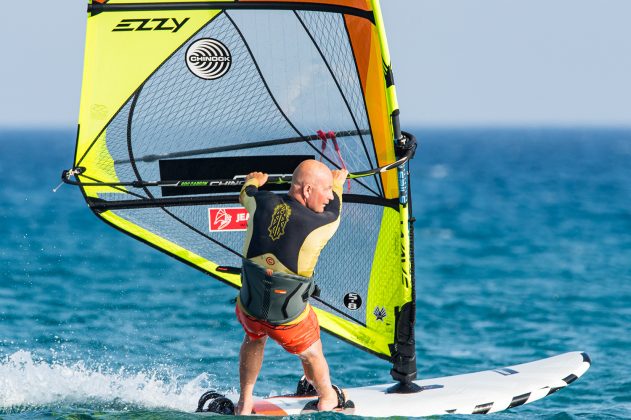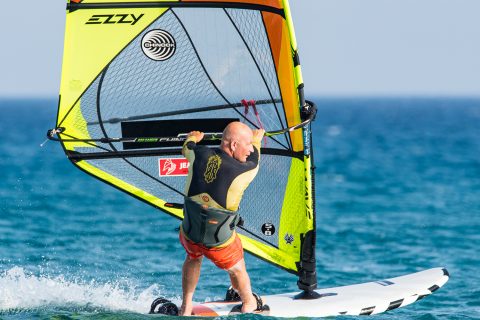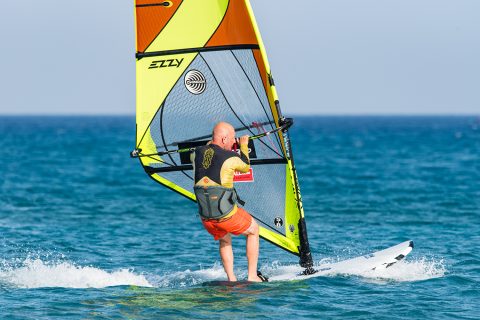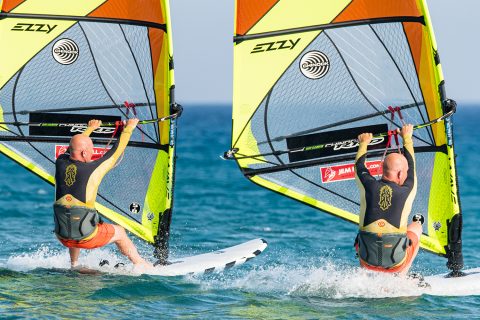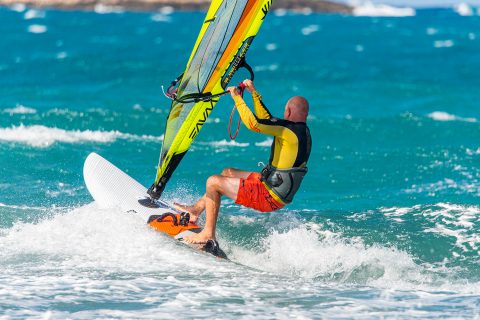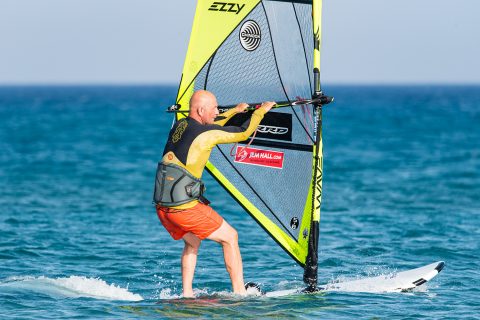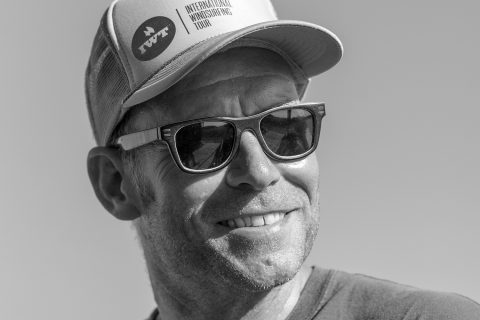JEM HALL
MOVE ON UP – WINDSURFING TECHNIQUE
EARLY PLANING
Jem Hall, and his photographer / assistant coach, Nick Jones(Eye Sea You Photo), give us tips for early planing.
WORDS – Jem Hall, Nick Jones. // PHOTOS – Eye Sea You Photo.
This month we look at what I feel is the most important skill to allow us to enjoy our great sport more and often progress faster, this being ‘early planing’. Many people come on my trips and want to learn a plethora of moves or skills, but few name early planing specifically. Yet I can safely say that the biggest area that all my students improve in during a course is the ‘Trinity’ of basic skills – planing early, going upwind and going fast. In this piece I will highlight outline some key tips for early planing and give some early planing challenges that will ensure you improve even more.
- Plane earlier and accelerate by angling your torso forward, pulling down on your front hand and pushing down through the toes on the front foot.
Late to the party
We all love the feeling of the board releasing and gaining speed and then flying along over the water, it is what likely hooked us in the first place and what keeps our enjoyment up. Through many years of coaching and observing, I can tell you what is stopping you from planing early.
- BFA / SBL – this means ‘bent front arm’ and ‘straight back leg’ and these are the 2 biggest hindrances to early planing. The BFA chokes the rig and shuts off its available power. The SBL sinks the tail and places you too upright. If you exhibit a BFA you will have a SBL as the rig gives you no power to hang off it.
- Too far – positioning your hands too far apart, and mainly front hand too far forward, again chokes the rig’s power, and loses you leverage.
- Oversheeting – this comes from the previous point in that with your hands far apart the back hand can pull the sail in too hard and oversheet it. Heading downwind often helps us plane earlier and on this course oversheeting kills planing.
- Thrusting – I am sorry to say it, but people are mainly not very good at hooking in, or out, and so just as they get a bit of speed (unhooked) they then hook in by standing up too tall and pulling the boom in too far and this will then choke a lot of power out of the rig.
- Losing shape – you might be near planing, heading off the wind, and then as you put your front foot in the strap you bend the front arm or straighten the back leg. Both will apply the handbrake.
- Gear Gazing – you look at the sail or your feet, this loses you leverage and brings us on nicely to the next point.
- You just can’t see it – poor wind awareness of gusts and lulls means you don’t take the opportunity to plane with a gust, or try and get planing in a lull.
- You can’t change – this is mainly not bearing away enough, and changing course, to get more power from the wind and water flowing over the fin.
- Fear – you may be nervous about really putting the rig in a powerful position and committing to its power. Being at, or near, to catapulting is the best strategy to plane really early. Catapulting is part of the planing early journey, and windsurfing life!
- Poor starts – beach / waterstarting with your hands and feet poorly positioned will place you in a weak position to then get planing.
- Foot position – back foot too far back or too close to the windward edge will upset the board, and yes this can come from a bad start.
- Bad pumping – most people pump badly as they do not ‘extend and bend’. This action will waste energy and sucks the power out of the sail.
- Mindset – many think ‘I won’t get planing’ and this negative self-dialogue will often reflect in poor decision making and bad technique.
- Poor kit choice – a few examples are too small a board, the wrong type of board, a very flat sail, too much downhaul and too low a boom.
- Not staying out – when the wind drops a little, people migrate back to the beach, this means they lose the opportunity to tweak their early planing technique.
- Fitness – a poor power to weight ratio will see you planing later. I am 90 kg, I’m not light, but I work hard to be fitter and stronger so I can get planing, and it really helps! I notice every extra kg. Having fitness in the bank helps me with a positive mindset too.
- Bending your front arm and straightening your back leg shuts down planing!
Let it go
So before I boost your early planing, you might be thinking why? Well if you are planing earlier it is easier to keep planing in light & gusty conditions, you will get more runs in over a session and then you can try more moves, you will also be quicker to get out of the whitewater zone in waves and thereby give you more possibilities for jumping, or even getting out the back. Mainly you will have more fun and more than likely you can begin to use smaller, easier to handle kit.
I strongly advise you to recap on my recent “handy hints” piece from the June ’22 issue, as this is of paramount importance here, and also please reacquaint yourself with my changing lines piece from Jan / Feb ’21 issue.
- Extend and bend and hold your shape as you pull down on the boom when looking to plane and get in the front strap.
Main tips to plane:
- Chug it – if there is not enough wind to plane, then sail upwind non-planing, which is what I call ‘chugging’ upwind, using the windward (upwind) rail as a kind of daggerboard. You will then be upwind, in the best position to make the most of any gusts coming your way.
- Extend and bend – pull down hard on front arm and bend your back leg, this is a game changer. Get your head at boom height at least. This will power up the sail and flatten the board so it is not creating drag.
- Narrow your hands – moving your front hand back is huge. It will feel weird at first, but go with it. This action in turn will make you move your hips more and be in tune with changes in power in the sail.
- Foot position – your front foot should face forward, not across the board, when not in the front strap. The back foot should be in the middle of the board, touching the front strap in less wind and moving aft when you have more power.
- Use your harness – if you really engage your weight in the lines then you have to drop your hips and extend your front arm, and this is all good practice. Plus it saves energy!
- Experiment with sailing lines – aim to plane a little closer to the wind in lighter conditions, you can go broader (more downwind) when windier.
- Horses for courses – smaller boards with less tail width and inevitably smaller fins need to go more downwind to plane to get the board speed up and water flowing over the fin to generate lift. Practice this action on bigger gear to get used to it.
- One handed – if it is marginal and I am near planing, and I am already in the front strap, I often drop my front hand (to stop me bending it). This will also stop me from oversheeting with the back arm. Try it!
- Use the ocean – when we are sailing there are bumps everywhere, so you can use waves to gain momentum, even chop can give you a little boost.
- Lazy pumping – this is the action of pulling in with the back arm / shoulder (whilst hooked in) and bending your back leg as you really push through a straight front leg. Being hooked in will give you a good body position, and plenty of mast foot pressure, so the pumping action can generate flow over the sail to release the board.
- Angle your torso – as you accelerate angle your upper body like you are trying to look around the mastfoot, whilst you push down on the front leg and mainly through the toes to keep the board flat.
- Better tuning – if you want to plane earlier try moving your boom up a cm or 2, letting off your outhaul, moving the mastfoot, or changing your fin size up. Above all, experiment and reflect and get to know your kit.
- Keep low out of your gybes in the waves and get into the front strap, before hooking in, to avoid crashes and get up to speed quicker.
Jem’s planing challenge
Whilst many of you might plane pretty early and can do this with good power and when hooked in, I want to now set you some challenges to work on so you plane even earlier, gain more skills and develop valuable windsurf fitness too. It is worth refreshing the 3 options you have to get planing from my August 2015 piece.
- Get planing without hooking in – yikes, yes it can be done, but can you do it? When it is windy, or you have good power, try getting down really low, on long arms and get planing into the front strap, maybe even both straps, before you hook in. This active planing is a very important skill and will yield fewer crashes in strong winds, and will give you planing gybes. Note – hooking in before planing places you in a weak (likely to catapult) position, and hooking in also chokes the rig, lastly hooking in is best done across the wind, whilst getting planing is best done off the wind.
- Get in the straps non-planing, both ways – keep the board flat and really pull down on the boom. Try not to oversheet and then from here try and get planing. This is called ‘New School’ planing and is a game changer and huge skill builder. Being smoother at getting into the straps will really help you.
- Get planing one-handed – this is amazing! It is best done from being in 1 or both straps and a standing / non – planing start. It will get you trimming the rig better with your back hand, moving your hips and steering the board more precisely with your feet. It will also help you feel what your kit is telling you. Too much or not enough outhaul for example.
- Go naked – well not quite, but take off your harness and do a few runs non-planing to feel where the rig should be positioned. Then come in, have a little break and aim to plane out and back twice without your harness. The record for my students is 10 reaches out and back.
- Jump to it – for wave sailors, in waves plane out of a gybe or come out of a tack and then get up to speed and do an early jump, without hooking in.
- Ride it – again for wave sailors, tack, or gybe, onto a wave to catch it, then get in the straps using wave energy, and then go straight into a wave ride, should the wave be peaking up enough. This will see you get more rides when you see a nice wave on the way out.
- Learn to get in the straps non-planing, and then get planing from here, to boost your early planing options.
All in the T’s
When I am coaching a beach session in gusty conditions I outline what the four main areas are for planing early. The first two are land based, and the last two take place on the water.
- Tuning – look at the conditions and consider what you can do with your kit to help you to plane.
- Temperament – this is your mindset. Believe you will plane and have a positive self-dialogue.
- Timing – see the gust and then bear away to get planing, and also just after you feel the gust in the rig.
- Technique – extend and bend, to get that rig upright and board flat.
- Nick Jones
Nick’s nuggets
First thing to say is, be patient! If conditions are marginal, and I’ve made a couple of futile attempts to get going, then I reset and refocus. Frantically trying to pump the sail while jumping all over the board is only going to jack up the frustration levels.
So if I’m not getting going I’ll think about my technique first. Where are my feet? Is my back foot too far back and so sinking the tail? Am I sheeting in too much?
Next I will consider my strategy. Perhaps I need to bear away more to gather speed. If there is swell – I won’t try to get planing going ‘uphill’, but rather use the swell to generate some board speed. Also, if it is gusty, I will try to time my effort for a gust that hits me while I am on the swell, rather than behind it.
Once I have exhausted my technique options and I’m still not going, then I will think about my tuning. Is the boom too low? Too much outhaul? Too much downhaul?
And then, if I am still not going, well I just have to accept that it’s a non-planing session and so then think what can I practice to improve my level? Perhaps I practice chugging upwind, non-planing gybes and tacks, practice clew first sailing or light wind waterstarts.
But my top tips for getting good at early planing are sail more in marginal winds, i.e. give it a go, don’t just stand on the shore wishing you had bigger kit! And get yourself a windsurfing SUP! Sailing slowly in light winds, you really get to understand the impact of small adjustments in technique upon board speed.
Ezzy sails, RRD (boards, wetsuits & softwear), Chinook & Black Project fins sponsor Jem Hall. Get him live and direct on one of his highly acclaimed coaching holidays – check out his website www.jemhall.com for details. You can also follow him on twitter / Facebook / Instagram.

